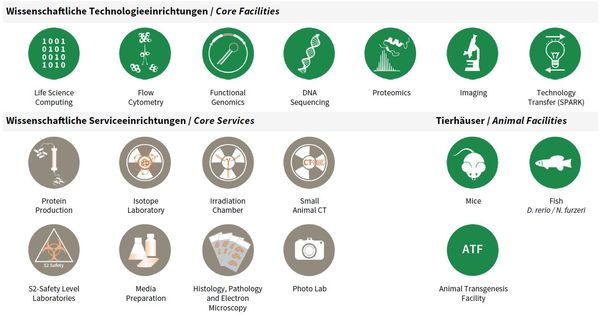Core Facilites and Core Services
At the beginning of 2016, a “core” structure was put into effect that organized facility and service units as independent organizational entities from FLI’s research groups. A number of technology platforms (e.g. sequencing, mass spectrometry) grew out of individual methodological requirements for single research groups in the last years but developed into semiautonomous substructures. As consequence of re-focused research activities and the concomitant advent of new research groups at FLI, those units increasingly had to serve many FLI groups and collaborative research efforts in the Jena research area.
To accommodate this development and to increase efficiency as well as transparency for users, facility personnel and for administrative processes, it came natural to re-organize such activities into independent units as “FLI Core Facilities and Services” and to phase out infrastructures considered non-essential for FLI’s research focus (X-ray crystallography and NMR spectroscopy).
FLI’s Core Facilities (CF) are managed by a CF Manager and are each scientifically guided in their activities and development by an FLI Group Leader, as Scientific Supervisor. The animal facilities comprising fish, mouse and transgenesis are run separately, as they involve a more complex organizational structure. Basic Core Services (CS) are directly led by the Head of Core (HC), who in turn is supported by individual CS Managers.
All facilities and services, including animal facilities, have a valuable contribution to FLI’s research articles; e.g. from 2016–2018, to 54% of all peer reviewed research publications.
Overview Core Facilities and Core Services at FLI.
Publications
(since 2016)
2017
- Kinetics of poly(ADP-ribosyl)ation, but not PARP1 itself, determines the cell fate in response to DNA damage in vitro and in vivo.
Schuhwerk H, Bruhn C, Siniuk K, Min W, Erener S, Grigaravicius P, Krüger A, Ferrari E, Zubel T, Lazaro D, Monajembashi S, Kiesow K, Kroll T, Bürkle A, Mangerich A, Hottiger M, Wang ZQ
Nucleic Acids Res 2017, 45(19), 11174-92 - TRE5-A retrotransposition profiling reveals putative RNA polymerase III transcription complex binding sites on the Dictyostelium extrachromosomal rDNA element.
Spaller T, Groth M, Glöckner G, Winckler T
PLoS One 2017, 12(4), e0175729 - Assessment of HDACi-Induced Acetylation of Nonhistone Proteins by Mass Spectrometry.
Wieczorek M, Gührs KH, Heinzel T
Methods Mol Biol 2017, 1510, 313-27 - NMR spectroscopic studies of a TAT-derived model peptide in imidazolium-based ILs: influence on chemical shifts and the cis/trans equilibrium state.
Wiedemann C, Ohlenschläger O, Mrestani-Klaus C, Bordusa F
Phys Chem Chem Phys 2017, 19(35), 24115-25 - Synthesis and Evaluation of Amyloid β Derived and Amyloid β Independent Enhancers of the Peroxidase-like Activity of Heme.
Wißbrock A, Kühl T, Silbermann K, Becker AJ, Ohlenschläger** O, Imhof** D
J Med Chem 2017, 60(1), 373-85 ** co-corresponding authors - A Stably Protonated Adenine Nucleotide with a Highly Shifted pKa Value Stabilizes the Tertiary Structure of a GTP-Binding RNA Aptamer.
Wolter AC, Weickhmann AK, Nasiri AH, Hantke K, Ohlenschläger O, Wunderlich CH, Kreutz C, Duchardt-Ferner E, Wöhnert J
Angew Chem Int Ed Engl 2017, 56(1), 401-4
2016
- Polymorphism of Amyloid Fibrils In Vivo.
Annamalai K, Gührs KH, Koehler R, Schmidt M, Michel H, Loos C, Gaffney PM, Sigurdson CJ, Hegenbart U, Schönland S, Fändrich M
Angew Chem Int Ed Engl 2016, 55(15), 4822-5 - Longitudinal RNA-Seq Analysis of Vertebrate Aging Identifies Mitochondrial Complex I as a Small-Molecule-Sensitive Modifier of Lifespan.
Baumgart* M, Priebe* S, Groth* M, Hartmann* N, Menzel U, Pandolfini L, Koch P, Felder M, Ristow M, Englert C, Guthke R, Platzer M, Cellerino A
Cell Syst 2016, 2(2), 122-32 * equal contribution - FRAMA: from RNA-seq data to annotated mRNA assemblies.
Bens M, Sahm A, Groth M, Jahn N, Morhart M, Holtze S, Hildebrandt TB, Platzer M, Szafranski K
BMC Genomics 2016, 17(1), 54 - Discovering miRNA regulatory networks in Holt-Oram Syndrome using a Zebrafish model
D'Aurizio R, Russo F, Chiavacci E, Baumgart M, Groth M, D'Onofrio M, Arisi I, Rainaldi G, Pitto L, Pellegrini M
Front. Bioeng. Biotechnol. 2016, 4, Article 60









